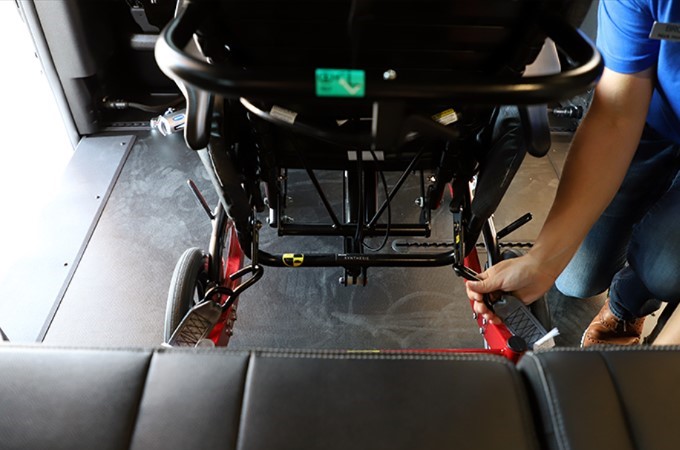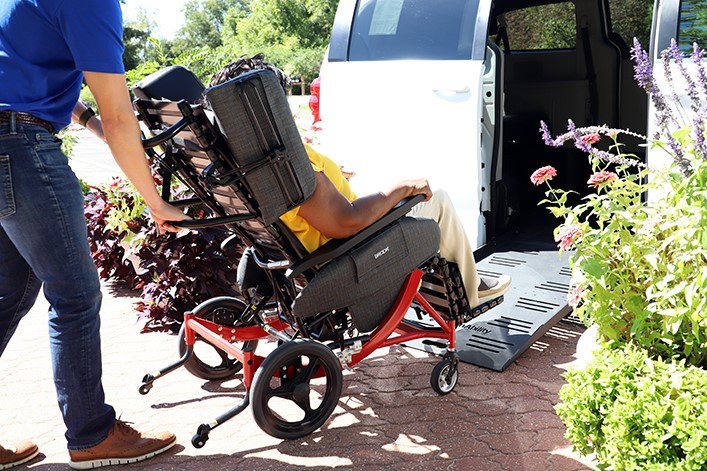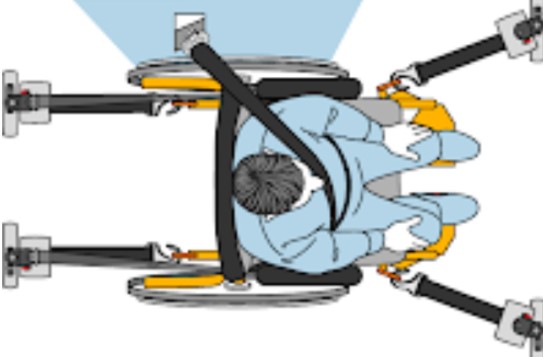
Transport of disabled persons: Wheelchair Transportation Safety Checklist
Know Before You Go: every wheelchair user is entitled to the freedoms and benefits of travel. Safe wheelchair transportation is essential for completing some activities of daily living (ADLs)
This type of mobility is also important for staying connected to friends and family in one’s community.
Using a wheelchair as a vehicle seat does pose several risks if not done properly
These include injuries during transfer to the vehicle, improper securement of the wheelchair, poor driver education on how to assist a passenger in a wheelchair, and many other risks.
Use this helpful guide to facilitate successful, safe, and comfortable vehicle travel with a mobility device.
Choose a Wheelchair that is Safe for Vehicle Travel
The first step to a safe trip is to only use a wheelchair that is certified for vehicle transit.1
Consider national and international standards for wheelchair travel safety.
For example, in the United States, the WC19 standards establish a set of criteria for the manufacturing, testing, and performance of wheelchairs in vehicle transportation scenarios.2
Next, look for the WC19 label to identify certified wheelchair models.
You can also search for specific manufactures and models to ensure they are listed on the Crash Tested Product Lists.
A safe wheelchair will have a sturdy, crash-tested frame, well-fitting seatbelts, and four, welded anchor points for securing the wheelchair to the floor of the vehicle.3
Plan for the Vehicle You’ll Use
There are many different vehicle options when traveling in a wheelchair.
These range from privately-owned passenger vehicles, such as a van, to taxis, public buses, non-emergency ambulances, or even a motor coach.
Each requires a different boarding and disembarking procedure.
If you will be traveling in an unfamiliar vehicle, plan ahead by learning the type of ramp or lift, how to operate that equipment, and where boarding can safely take place.4
All vehicles designed to carry wheelchair users should include suitable Wheelchair Tie-Down and Occupant Restraint Systems, or WTORS.
Before the trip, make sure the WTORS in your vehicle are WC18 certified and suitable for your wheelchair type.
Check that there is sufficient space to correctly fit the tie-down system to the wheelchair and the occupant restraint to the passenger.4
A common type of tie-down is a 4-point hook system, which connects to special brackets on a WC19 wheelchair.
Prepare the Vehicle for Boarding
First, park the vehicle in an area safe for loading with enough room for the ramp or lift.
Avoid high-traffic streets, uneven terrain, or tight spaces.
Next, check the surroundings for obstacles and deploy the ramp or lift to prepare for boarding.
Make sure the ramp is level with the ground.
Finally, assist the passenger onto the ramp or lift, taking your time to make sure the passenger is stable, and the wheelchair is balanced.
The loading and disembarking processes may be time-consuming, depending on the needs of the individual traveling, but it’s worth it to take your time to avoid equipment malfunction, wheelchair damage, or injury.
Make Sure the Wheelchair is Properly Positioned & Secured
After the passenger has been loaded onto the vehicle, position the wheelchair facing toward the front of the vehicle in the direction of travel.
Research has shown that a forward-facing position is the safest in the event of an accident.1
Avoid placing the wheelchair in a location that blocks the vehicle exit for other passengers.
Engage the parking brakes on the wheelchair to minimize shifting in transit.
If travelling in a power wheelchair, switch off the power unit during transit to remove the possibility for accidental propulsion.4
While useful, parking brakes alone are not sufficient to prevent movement of the wheelchair during travel.4
Additionally, you will need to secure the frame of the wheelchair to the floor of the vehicle.
If you don’t secure the wheelchair to the floor, then it will slide around as the vehicle moves, causing hazards for the wheelchair users as well as any other passengers.
Use a four-point strap system, with two straps in the front of the wheelchair and two in the back.
This will eliminate twisting, shifting, rolling, and other unsafe movement.
Never attach the straps to any part of the wheelchair that is removable, such as the footrest or headrest.1
These pieces can shift or break, especially in the event of an accident.
Instead, for WC19 certified wheelchairs, attach the hooks to the special brackets located on the frame.
Fasten all hooks tightly with no slack in the straps.
Attach the rear straps to a tie-down point that is directly behind the hook on the frame of the wheelchair.
Attach the front straps to points on the floor that are slightly wider than the wheelchair.3
Secure the Passenger in the Wheelchair
After taking precautions to secure the wheelchair to the vehicle, you must also secure the passenger to the wheelchair by using secure occupant restraint belts.1
Transport wheelchairs come with a travel-safe seatbelt.
Some vehicles also have built-in seatbelt restraints.
Make sure the seatbelt fits snugly over the passenger’s pelvis and does not ride up onto the abdominal area.
Never settle for the use of positioning lap and shoulder belts, as these are intended for postural support only and will not keep the passenger safe in the event of a crash.
Finally, remove all wheelchair-mounted accessories, such as trays, oxygen tank holders, bags, or any other type of attachment, and secure them safely in the vehicle.1
Know Your Rights to Safe Transportation
In short, everyone is entitled to a safe ride on any bus, regardless of use of a mobility device.
This means that by law, every public bus must have a wheelchair tiedown system and an occupant restraint system.
Transportation companies and paratransit service providers also offer suitable accommodation for passengers in wheelchairs.
Additionally, bus and van drivers are legally required to help a passenger secure their wheelchair and assist with occupant restraint systems.
Never settle for unsafe conditions and always request additional assistance if something doesn’t feel right.1
References
The Rehabilitation Engineering Research Center on Wheelchair Transportation Safety. (2008, January).Best practices for using a wheelchair as a seat in a motor vehicle. http://wc-transportation-safety.umtri.umich.edu/consumers/bestpractices
University of Michigan Transportation Research Institute. (n.d.).WC19: Wheelchairs – WC transportation safety. Retrieved September 10, 2021, from http://wc-transportation-safety.umtri.umich.edu/wts-standards/wc19-wheelchairs
Craig Hospital. (2015, March) Safe personal vehicle travel guide for wheelchair users (#859). https://craighospital.org/uploads/Educational-PDFs/859.TravelGuide-PersonalVehicle.pdf
Medical Devices Agency & Northern Ireland Adverse Incident Centre. (2001, November).Guidance on the safe transportation of wheelchairs. http://btckstorage.blob.core.windows.net/site4667/Best%20Practice/Handover/Guidance%20on%20the%20Safe%20Transportation%20of%20Wheelchairs.pdf
Read Also
Emergency Live Even More…Live: Download The New Free App Of Your Newspaper For IOS And Android
What To Do After A Car Accident? First Aid Basics
First Aid For Road Accident Victims: What Every Citizen Needs To Know
RICE Treatment For Soft Tissue Injuries
Rescue Operations In Car Accidents: Airbags And The Potential For Injury
Stretcher Or Chair? No Doubts With The New Spencer Cross Chair
SPENCER 4BELL: The Lightest Transport Chair Ever. Discover Why Is It The Most Resistant One!
Ambulance Chair, A Lightweight And Easy To Handle Solution From Spencer
Emergency In Airports: How Is An Evacuation From The Airport Provided?
HL7 International Board Appoints Patricia Van Dyke As The Chair-Elect
Evacuation Chairs. A Comparison Sheet To Check Out The Strengths Of Each Model At A Glance




